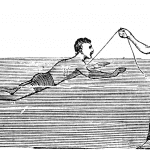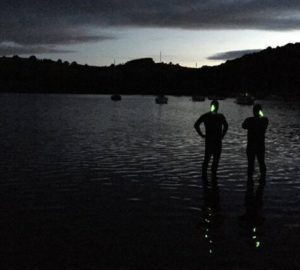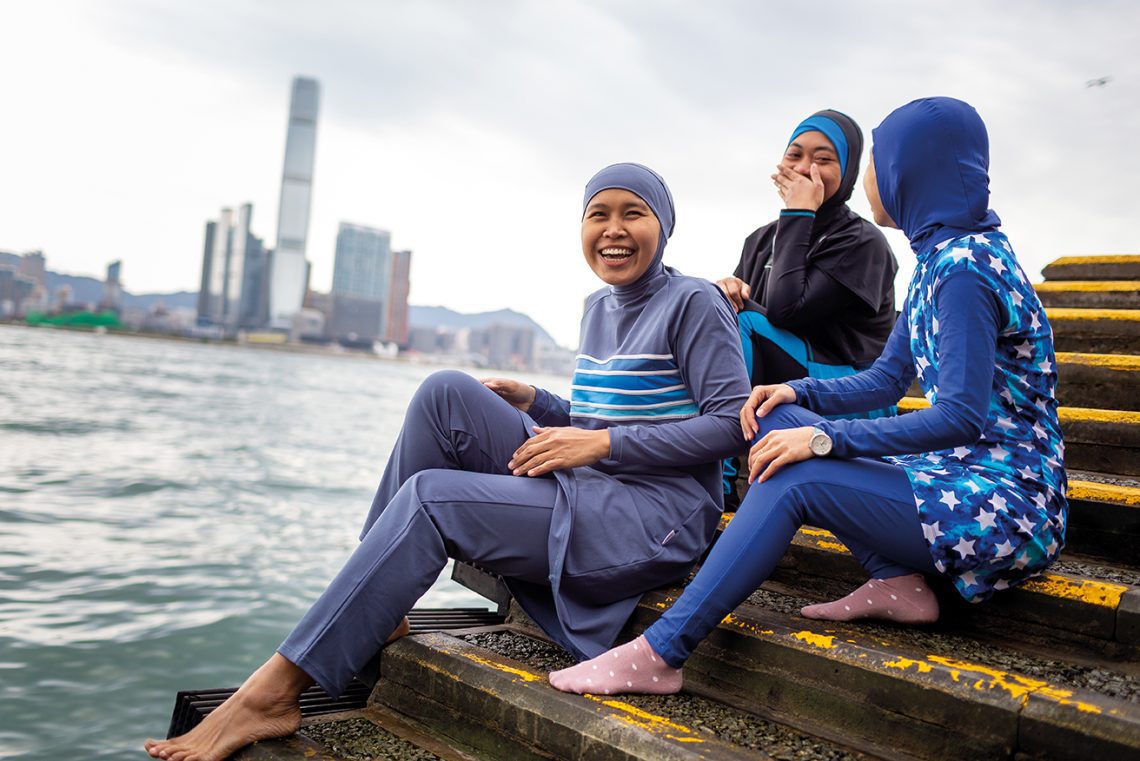
The Burkini Line
In the strained relations between the West and Islam, have we lost sight of what swimwear is really for? Simon Holliday looks at the history of the burkini and its role in empowering Muslim women to take to the open water
The sun has only just arisen as a young woman emerges from the water in a long-sleeved black polyester tunic, hood (or ‘hijood’) and body suit. She is covered completely barring hands, feet and face. “Coach, we swam to Middle Island beach and back,” she beams, switching quickly to Bahasa to make a joke not meant for everyone’s ears, then giggling and darting for cover under a lifeguard tower.
Two dozen high-spirited Indonesian and Filipino women are swim training this morning in Repulse Bay on Hong Kong’s south-side, a distance from the recent protests downtown. Burkinis or full coverage swimsuits are not uncommon on this beach. Many Chinese swimmers wear body suits and even ‘face-kinis’ with eyes, nose and mouth holes to avoid sun exposure. Paddlers skirt the perimeter safety nets in rash vests, compression pants, wraparound sunglasses and visors. A diver waddles in a thick neoprene suit. Each person dressed to suit their needs and taste. No one bats an eyelid at the young woman’s burkini. Like everyone else on the beach this morning, they are there to enjoy the water.
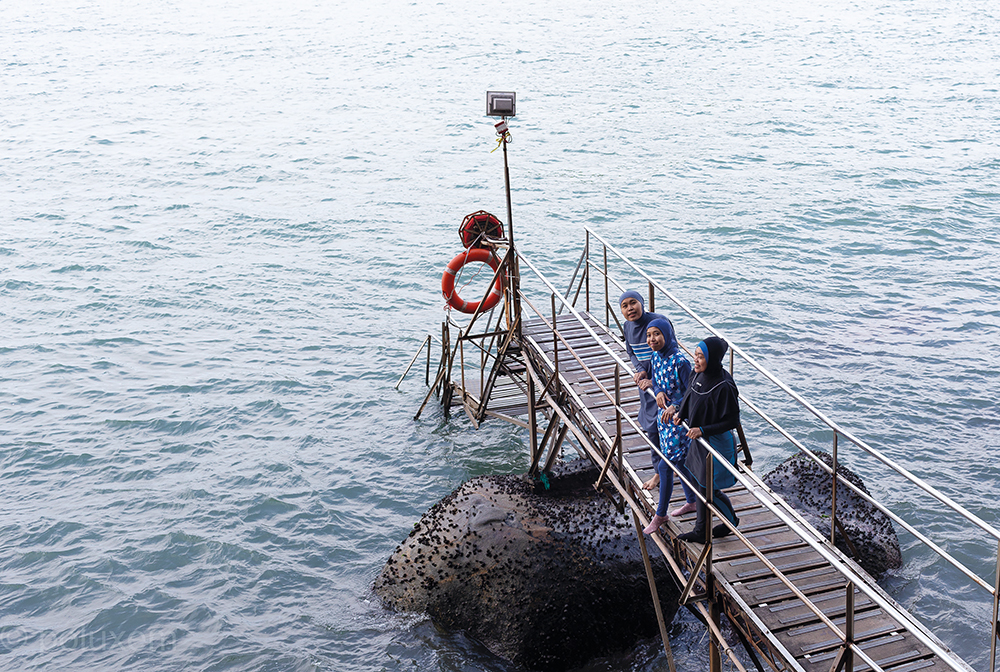
Attacks on the French Riviera
Compare this scene to emotionally charged beaches on the French Riviera in the summer of 2016. France was still recovering from a cargo truck deliberately driven into crowds celebrating Bastille Day on Nice’s Promenade des Anglais. Islamic State claimed responsibility for killing 84 people and injuring over 200. Then Prime Minister, Francois Hollande, called a state of emergency.
A month later, the Mayor of Cannes, David Lisnard, singled out the burkini “…as a uniform that is the symbol of Islamic extremism”, banning the garment from their beaches. Other mayors followed suit. “I voted to ban the burka in public places,” said Daniel Fasquelle, Deputy Mayor of Le Touquet. “There is no reason why it should be tolerated on the beach”. Weeks later at the same beach, a picture circulated of armed male police officers forcing a Muslim woman to remove her tunic on the beach by Promenade des Anglais.
Rupert Colville, UN Human Rights Office Spokesperson, said the bans were “a grave and illegal breach of fundamental freedoms, fuel[ing] religious intolerance and the stigmatisation of Muslim… that have only succeeded in increasing tensions”. People who wear burkinis or any another clothing “cannot be blamed for the violent or hostile reactions
of others.”
A few weeks later the bans were lifted. Not only was it difficult to enforce (with people covering up at the beach for a variety of reasons), it was also deemed ‘illegal’ by a French court as risks of disruption to public order could not be proved. The Administrative Court of Nice ruled that “in the absence of such risks, the emotions and the concerns resulting from terrorist attacks, and especially from the [Nice cargo truck] attack, are insufficient grounds to legally justify the contested ban,” adding that burkinis posed no risk to “hygiene, decency or safety when swimming”.
This summer the burkini was in the headlines again, when two French swimming pools were closed after a group of burkini-clad protestors staged a sit-in for several hours over a
ban of the garment, and had to be forcibly removed.
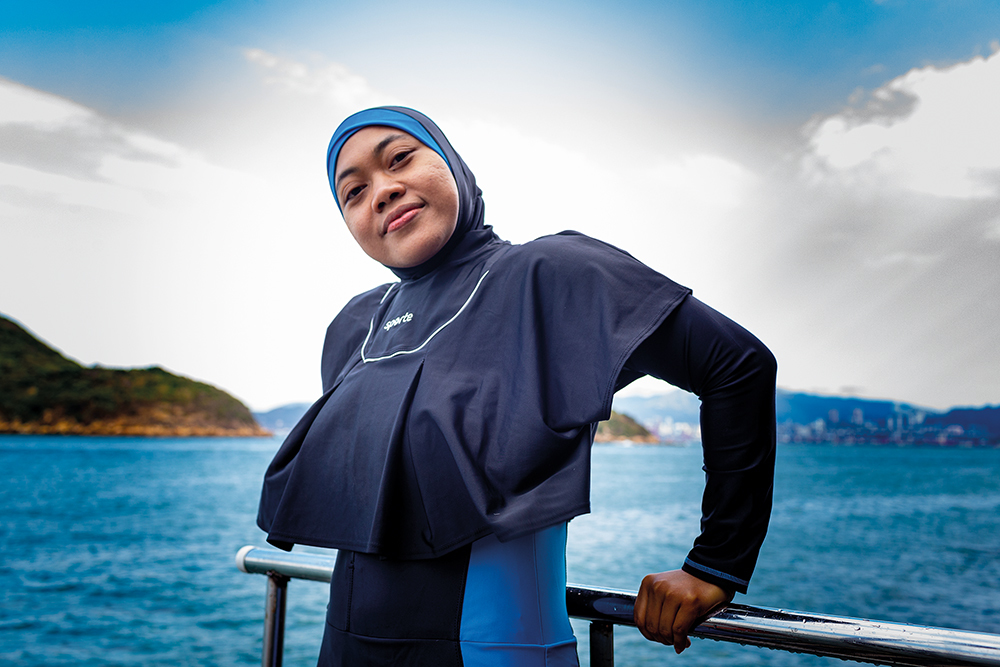
Life is short, buy the bikini
Not since the original bikini has a swimming garment caused such consternation. Created in 1946 by French automotive engineer, Louis Réard, ‘le bikini’ took its name from Bikini Atoll, a tropical South Pacific US outpost and Cold War nuclear test site.
Réard’s cleverly marketed two-piece swimsuit caused shockwaves along the beaches of the French Riviera, beginning with the original blonde ‘bombshell’ Brigitte Bardot controversially posing in a floral bikini during the 1953 Cannes Film Festival.
Then came the fall-out. Pope Pius XII called the bikini “sinful”. Regulations were introduced to restrict bikini-wearing in Australia, Belgium, Italy, Spain, Portugal, France and the United States. The bikini was banned from beauty pageants until 1977. The circumspectly named National Legion of Decency, an association of Catholic priests responsible for rating Hollywood motion pictures rated many films featuring women in bikinis ‘B’ (‘morally objectionable’) or ‘C’ (‘condemned’). Attempts to ban the bikini in the 1950s only made wearing them more appealing. “The bikini is associated with scandal and that’s why it survived”, said Killoren Bensimon, a former model and author of The
Bikini Book.
Ironically, the same seems to be happening with the burkini. The more it has been blocked and banned, the more it is politicised as a symbol of defiance against oppression. Aheda Zanetti, the inventor of the burkini, saw her sales rise from an average of 200 suits a month to over 2,000 in the aftermath of the 2016 French ban, with most orders coming from Europe.
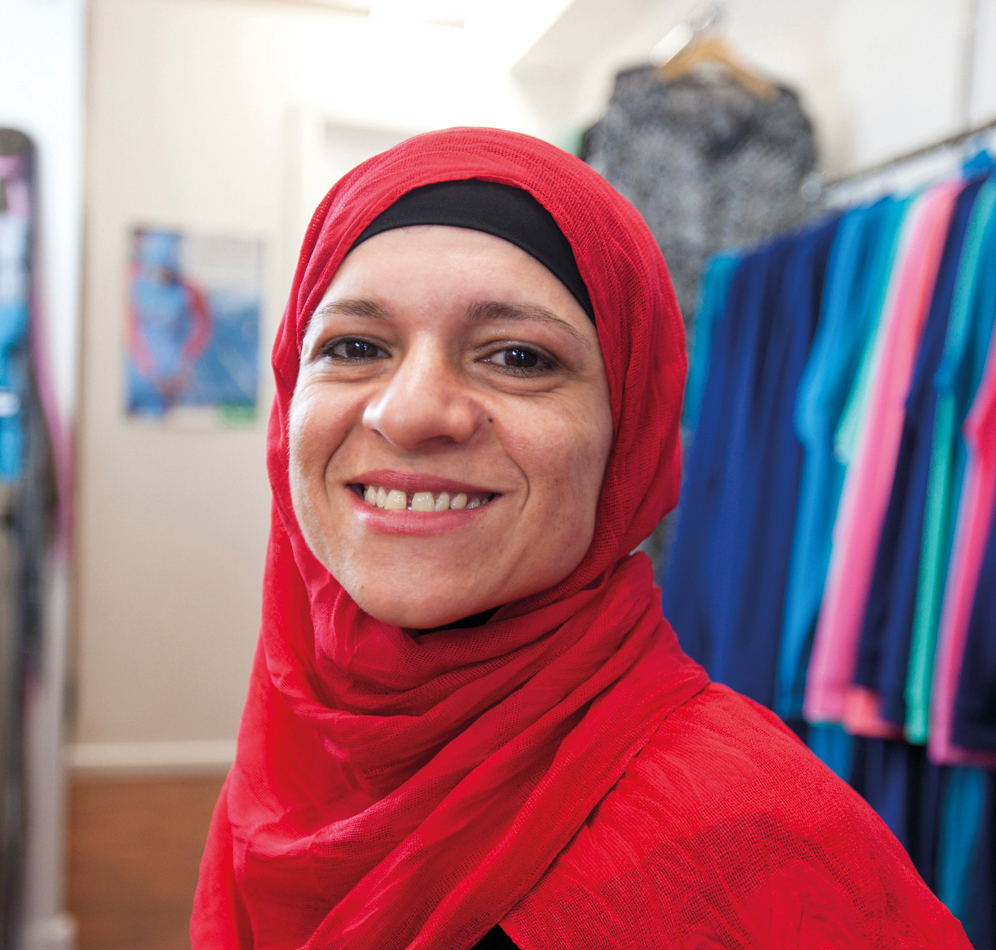
Aheda Zanetti
Enter Aheda
A few years ago, Aheda Zanetti’s colourful life was adapted for the Australian stage in The Modest Aussie Cozzie. Born in Lebanon, her family moved to Sydney when she was two years old. Growing up she enjoyed sewing and swimming, but stopped getting in the water when she started “growing boobs”, she reveals with typical Aussie candour. She left school at 15 to become a hairdresser, although continued following her passion for dressmaking. At 18 years old, she was married and at 21 she gave birth to a son. But within two months, her husband was hit by a car and fell into a coma. He passed away three years later.
A decade on, she remarried a Greek man who worked for a truck company and just “wanted a quiet life,” she laughs, mischievously. At 35, having given up work to raise three babies born within a year of each other, she took a chance. With a little money she had borrowed, Zanetti launched her ‘burkini’ company, Ahiida at a local Islamic Fayre. “I made seven swimsuits of different sizes and just one design. You couldn’t buy one because I didn’t have any stock! I printed a leaflet with one question: “Would you wear this swimming?” The answer was resoundingly “yes”. Orders from Australia and beyond were steadily coming in. She leased a granny flat from a neighbour and
started production.
But things really turned for Zanetti after the Cronulla ‘race’ riots in Sydney in 2005. What began as a skirmish between a group of youths of Middle Eastern appearance and Anglo-Australian surf lifesavers, ended in mass riots across several southern suburbs of the city. To dampen tensions, the government launched a scheme to recruit surf lifesavers from Muslim communities. Zanetti designed a red and yellow two-piece suit so that Muslim women could patrol the beaches. The positive exposure drove sales and Zanetti, a 4”8’ tall Lebanese immigrant, became a national hero. “I was getting noticed in the street. My husband couldn’t handle it!” whoops Zanetti, as she unloads another round of quick-fire recollections. “I became – oh my God – like a movie star. I was asked to speak at Yale University and the United Nations. The Malaysian minister of Tourism thanked me for increasing tourism in his country! I could have been a billionaire.”
Zanetti is not a billionaire because her suits are relatively easy to replicate in style, if not always in quality. Zanetti owns the ‘Burkini’ and ‘Burqini’ trademarks, but there are now a range of cheap imitations available from companies selling on online retail platforms like Amazon and TaoBao. There are also upmarket boutiques such as Modanisa and No Ka’ Oi, and big players like Nike and Adidas entering the market with a range of Muslim-friendly active-wear. The market is steadily expanding as Muslim women demand more independence and opportunities to exercise.
But for Zanetti, it was never just about shifting swimsuits. “One day this lady came into the store”, she recalls. “She was going on holiday and wanted to buy a burkini. It seemed like a really big decision for her. She was a big lady, so I had to make her one personally. Two weeks later she came back crying. I sat her down and thought: what have I done? Has the swimsuit fallen apart? I was too scared to ask. Eventually, she told me. She had the most wonderful time of her life. It was the first time she had been able to swim with her kids. Her husband was so proud of her.”
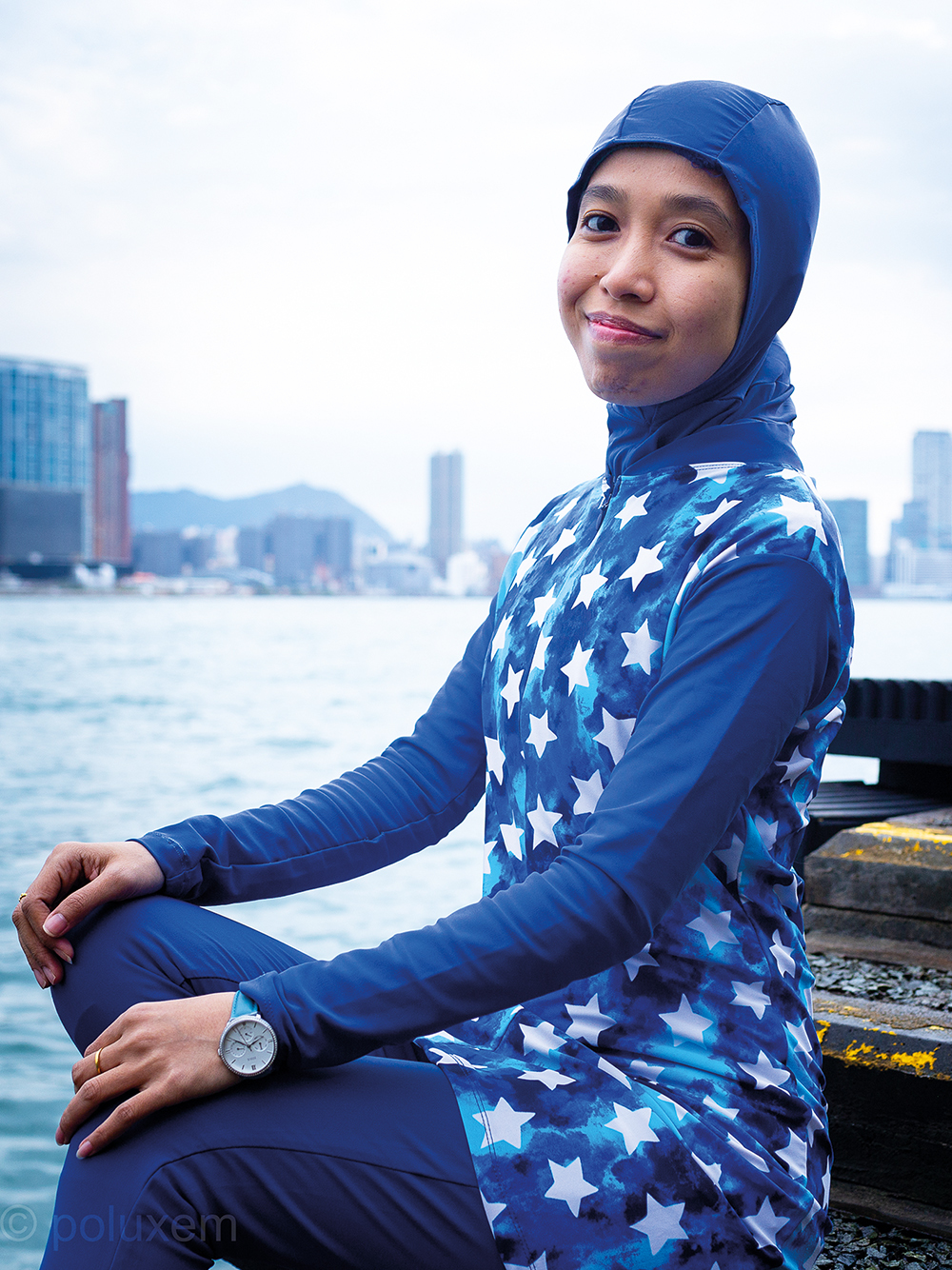
Swimming for freedom
A few kilometres from Repulse Bay there is an international school perched on a hill. Inside, a few floors down, there is a pristine swimming pool. Every Sunday, hundreds of women, employed by families in Hong Kong as live-in domestic workers, gather at schools like this one on their only day off. The goal? To pursue an opportunity they never had as a child – to learn to swim. They are taught by volunteers from Splash Foundation, a Hong Kong based non-profit swim school.
On deck a group of women excitedly await their final assessment. Eleven weeks ago, none of the women could swim. A few had never stepped into a body of water. A quarter of the class are Indonesian Muslims. Most – although not all – wear burkinis. Today is the culmination of all their hard work, where they cast their fears to one side and swim the length of a 25-metre pool. All of them make it across. If not for the burkini, they would never have even tried.
“Many people ask why I need to cover myself”, says Novi, a recent Indonesian Splash graduate. It’s our faith – it’s between us and Allah, our God. It’s our choice.”
“I wear the burkini for safety, freedom and [to feel] comfortable”, says Ani, another graduate of the programme. “Because I don’t worry about men thinking or ogling me when I swim.”
Not all Muslim women feel the need to wear the burkini. Many are comfortable wearing regular swim suits (although rarely a bikini). In parts of Indonesia and for Indonesians abroad what you wear in the water is a personal choice, not a political or religious statement.
The bikini and burkini have both been symbols of freedom. Freedom from modesty and a freedom to be modest. The shedding and the preservation of cultural-religious costume. These differences are becoming more apparent as the Western and the Islamic cultures rub against each other. Like skin on water-repellent polyester, something has been lost in the static.
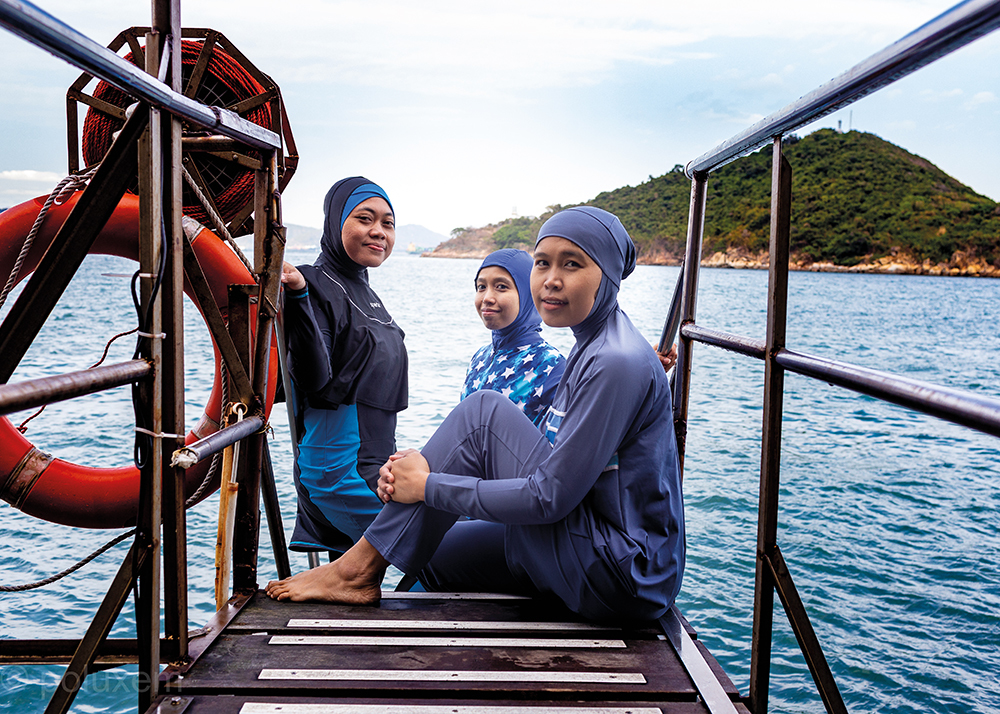
Swimming for all
The women swimming at Repulse Bay and at the international schools across Hong Kong care little about the burkini battles in Europe. In obsessing about what swimwear looks like and what it represents, we’ve lost sight of its utility, its purpose – to allow more women to enjoy the water.
It’s impossible to say how many of Indonesia’s 135 million women are able to swim, but most of the population have never been taught at school and therefore will likely never have had the opportunity to learn.
Accurate drowning rates for Indonesia are also impossible to obtain. Globally the World Health Organisation conservatively estimates that over 400,000 people die from drowning every year, dwarfing those related to religious wars and terrorist attacks. Even that figure does not include flood disasters or transport incidents. Most victims are kids from low income countries in Africa or Asia. Many of the women the Splash Foundation supports have a story of a near-death experience, or knew a friend or family member who drowned.
Some women learn to swim to be safe around water. Others learn for the sheer joy of it. “Being in the water makes me feel calm and happy. It changed me in the body and in mind. It changed my life.” says Susanna, an Indonesian domestic worker, journalist and swimmer.
The burkini was designed by a Western Muslim woman who believed faith and a desire to dress modestly should not be a barrier to the joy of swimming (moreover, 40% of Zanetti’s suits are sold to non-Muslims – Nigella Lawson famously wore one in 2011). Irrespective of what you wear, there is a freedom and sense of perspective gained in water that cannot be experienced on land.
Maybe the mayors and the mullahs could join us at Repulse Bay one Sunday morning. They might emerge from the water feeling differently to when they got in. Water, after all, treats everyone the same
Simon Holliday is a co-founder of Splash Foundation – an Asia-based charitable organisation in Hong Kong providing learn-to-swim programmes for adults and young people from under-served communities.
He is an avid swimmer having completed the English Channel in 2011, and more recently swims from Hong Kong to Macau and around Hong Kong Island.
Images: Maxime Vanhol, Poluxem Photography






